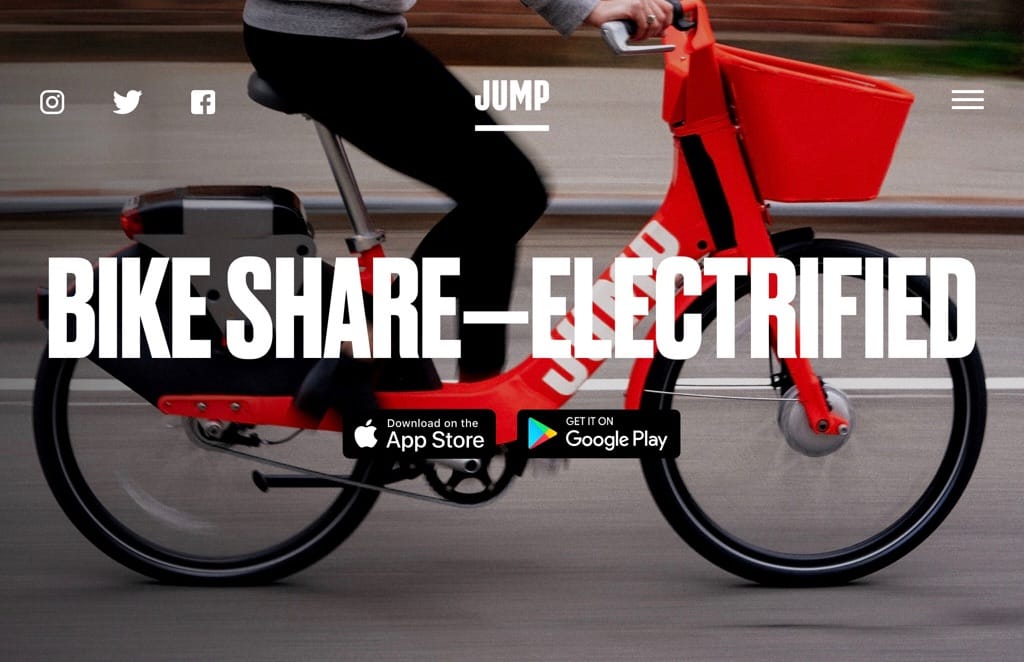
Teil 2 unseres großen Bündel-Thementages. Nachdem Meituan vor wenigen Tagen Fahrradsharing-Anbieter Mobike übernommen hat, hat Uber diese Woche den E-Bikesharing-Anbieter Jump Bikes übernommen. Das ist der erste, große Deal des neuen CEOs und gleichzeitig der erste, logische strategische Schritt von Uber seit langer Zeit. Gleichzeitig hat Uber diese Woche weitere Pilotprojekte verkündet, die, genauer betrachtet, in die gleiche Strategiekerbe schlagen.
Warum es wichtig ist: Uber macht den ersten Schritt zur alles umfassenden Mobility-App, deren Plattform im Hintergrund jeden Modus abdecken wird, um von A nach B zu kommen.
Jump Bikes und Bikesharing
Zunächst die BBC über die Übernahme von Jump Bikes:
Based in New York, Jump allows riders to rent electric-powered "pedal assist" bikes via an online platform.
Its bikes are also dockless and do not need to be returned to a specific place.
Uber, which already has a tie-up with Jump in San Francisco, said it would now look to "scale" the bikes globally.
Uber chief Dara Khosrowshahi said: "We're committed to bringing together multiple modes of transportation within the Uber app - so that you can choose the fastest or most affordable way to get where you're going, whether that's in an Uber, on a bike, on the subway, or more."
The bike-sharing market is growing at about 20% a year and is set to be worth between €3.6bn (£3.1bn) and €5.3bn by 2020.
Axios zum Hintergrund von Jumb Bikes und den Markt im Bikesharing:
Founder Ryan Rzepecki first got the idea to start a bike-sharing company in 2008, which was then named Social Bicycles. It had deployed more than 15,000 bikes in more than 40 markets, including outside the U.S., and recently raised $10 million in Series A funding from backers like Menlo Ventures, SOSV and Esther Dyson.
Market view: Other dockless bike-sharing companies include Ofo ($1.4 billion in total funding), Mobike (just sold to Meituan for $2.7 billion) , Spin ($8 million raised), and LimeBike ($132 million raised).
Uber hat in der Kooperation mit Jump Bikes vor der Übernahme festgestellt, dass die über den Fahrrad-Dienst zurückgelegte durchschnittliche Strecke 2,6 Meilen beträgt; was wohl einer durchschnittlichen Uber-Fahrt recht nahe kommt.
Also: Lieber selbst Bikesharing anbieten als sich den Markt von einem anderen Anbieter wegnehmen lassen.
Durch die bereits hohe Marktdurchdringung hat Uber in Städten, in denen sie seit langem aktiv sind, einen Datenvorteil gegenüber anderen Anbietern. New York Times
Uber said that the data from its ride network allows the company to understand the best locations to place the bicycles in different cities, so they can be used more frequently.
Since starting the pilot program a few months ago, Uber has found that the average distance of a ride on a Jump bike is about 2.6 miles — which is not much different than how far customers travel on average for an Uber car ride. Each bike is also being used six to seven times a day.
“The utilization of the bikes has been higher than expected,” Mr. Khosrowshahi said. “People are using these bikes for multiple trips a day.”
Wobei dieser Vorteil allerdings auch leicht zu überschätzen ist. (Dockless heißt unter anderem auch, dass die Fahrräder eben dort landen, wo sie benutzt werden.)
Recode über die Gefahr für Uber „von unten“, von Bikes bis Scooter:
The introduction of dockless electric scooters and bikes posed a clear threat to one aspect of Uber’s ride-hail business: Shorter trips.
In Santa Monica, for example, Uber is fending off scooter-sharing company Bird. The company, founded by former Uber executive Travis VanderZanden, completed 500,000 trips between September 2017 and March 2018. Bird is also now available in San Francisco.
Losing out on trips shorter than three miles may not seem like much on the surface, but it certainly adds up. In San Francisco, a three-mile Uber ride between the Financial District and the Mission could cost between $5 and $13, at the time of publication. [...]
In China, where dockless bike-sharing first took off, there were more bike-share rides between 2013 and 2017 than there were ride-share rides in the U.S. in that time. So there’s a big potential market for Uber to crack with e-bikes. [...]
Uber is also better positioning itself to compete with international players like Ola, which is testing its own bike-share service. Bike-share is taking off in markets around the world especially in places where local governments are growing increasingly concerned about pollution.
Eine letzte Anmerkung zu Jump Bikes: Das Unternehmen designt seine eigenen E-Bikes. Der erste Formfaktor, den Uber an die eigenen Anforderungen anpasst, sind jetzt also E-Bikes.
Autovermietung
Uber hat diese Woche weitere Pilotprojekte gestartet. The Verge:
Uber CEO Dara Khosrowshahi is in Washington, DC today to make a wide-ranging announcement on Uber’s plans to integrate a variety of new transportation options to its app, including bikes, car-sharing vehicles, and public transportation like buses and trains. Uber will also share more of its data on traffic patterns and curbside usage with cities in an effort to become “true partners to cities for the long term,” Khosrowshahi said.
Autovermietung:
Uber is also dipping its toes in the world of car-sharing. Later this month, Uber will launch a new product in San Francisco called “Uber Rent,” in which users can rent cars on Uber’s app through a partnership with Getaround. Uber and Getaround, a peer-to-peer car-sharing startup, have been working together in San Francisco for nearly a year to provide daily car rentals to people who want to drive for Uber but don’t own their own vehicle. Now, that service will be available to anyone who needs a car for a few hours or maybe a whole day — also through Uber’s app.
The company was founded in 2009 and has raised $88 million from investors including Toyota. Getaround sees its car rentals, which can be booked by the hour or the day, as complementing Uber and Lyft’s on-demand rides and helping to move Americans away from private car ownership. Getaround competes with other car-sharing platforms, such as San Francisco-based Turo and Daimler subsidiary Car2Go.
“Most of a person’s transportation needs can be met by coupling ridesharing for quick trips with carsharing for trips with multiple stops or longer getaways,” Getaround co-founder and CEO Sam Zaid said in a press release. “It’s the perfect combination for people who have chosen to live car-free.”
ÖPNV-Tickets bei Uber
Und last not least, ÖPNV-Tickets über eine Kooperation mit Masabi. The Verge:
Uber says it’s committed to providing further links to public transit. The company just inked a deal with London-based mobile ticketing company Masabi to allow Uber users to buy and use transit tickets on the app. The two companies are still working out in which markets and for what transit systems Masabi’s integration into Uber will work.
It will likely work much like Masabi’s partnership with Transit, a popular public transportation app in the US, in which users are able to browse fare types, make payments, and receive mobile tickets — all within the same app they use to hail Uber cars. Masabi’s mobile ticketing technology is currently being used by more than 30 transport authorities and operators worldwide, including New York’s MTA, Boston’s MBTA, the UK’s National Express Bus, Las Vegas’ RTC, Los Angeles’ Metrolink, and The Hague.
We deliver mobile ticketing and software-as-a-service (SaaS) based fare collection to public transport agencies around the globe, enabling passengers to use their smartphone as ticket machine and ticket, or the cards already in their wallet, to just ride.
Fazit
Einzeln leicht übersehbar, aber nimmt man alle drei Neuigkeiten zusammen, wird das Bild deutlich: E-Bikesharing, Autovermietung und ÖPNV-Ticketing, vereint in der Ridesharing-App Uber, zeichnen gemeinsam ein deutliches Bild, wo die Reise hingeht.
Uber ist nicht das einzige Unternehmen, das der One-Stop-Shop für alle Mobility-Belange werden möchte. Unternehmen wie Citymapper aus London oder Door2Door aus Berlin (Allygator) nähern sich diesem Ziel aus anderen Richtungen. Keines dieser Unternehmen hat allerdings eine solche Marktmacht, einen Kundenzugang, wie Uber in wichtigen Märkten wie den USA. Das war und ist das Versprechen von Uber und co. an die Kapitalgeber: Mit Ridesharing wird der Markt aufgemacht, hat man dann einmal die Kunden, kann man ihnen auf dem Angebot alles anbieten, was sie sonst noch transporttechnisch benötigen. Deshalb war der Vergleich von Ubers Potenzial mit dem Taximarkt immer großer Unsinn. (Das Gleiche gilt für Didi Chuxing, das in China, fast ungestört, sich ebenfalls in diese Richtung entwickeln kann.)

